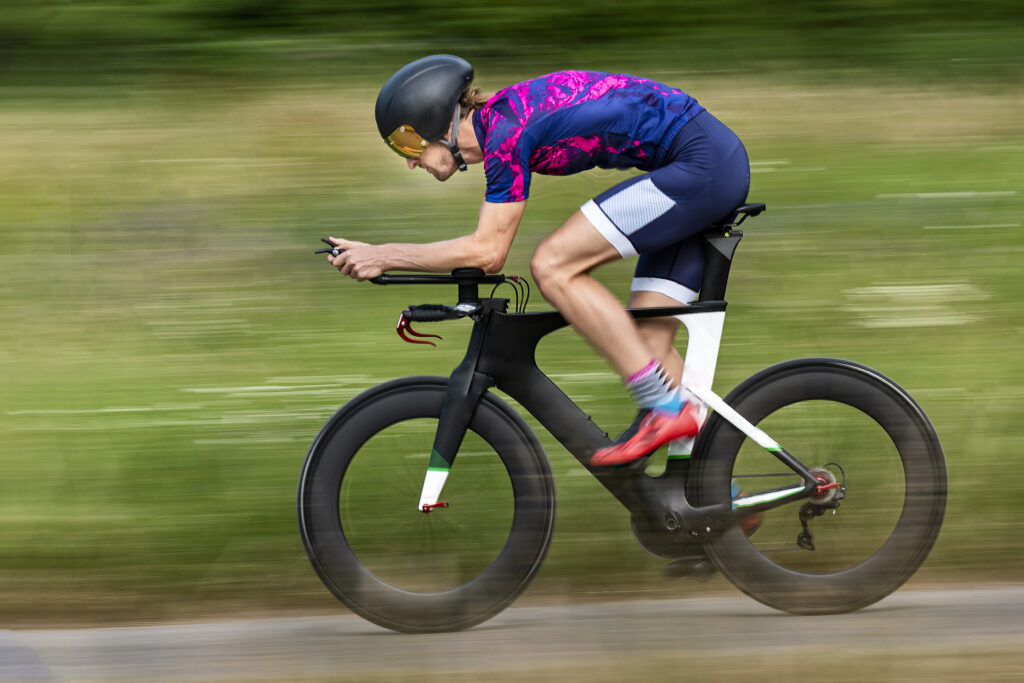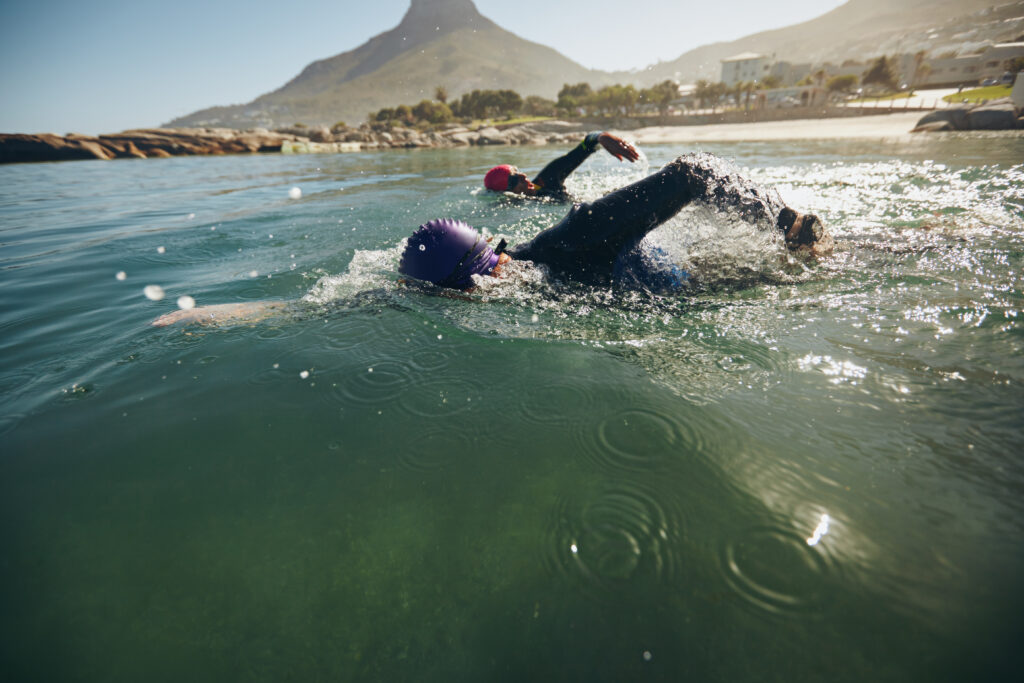
So you signed up for your first triathlon and aren’t sure where to start. The good news is, it doesn’t have to be as daunting as it seems! As a 4x World Champion in short course triathlons, I’ve done more than my fair share of triathlon prep. Now I’m here to help you prepare for your first triathlon and offer some tips and tricks to make it a more enjoyable experience.
Different Triathlon Distances
First things first, you need to choose your distance. There are a lot of different distances to choose from, so here’s a quick overview of what’s on offer.
- Super-sprint: ¼ mile swim, 3.1-mile bike, 1-mile run (some of these distances may change but it is roughly ½ to ¼ of the distance of a sprint triathlon)
- Sprint: ½ mile swim, 12.4-mile bike, 3.1-mile run
- Olympic: 1-mile swim, 24.8-mile bike, 6.2-mile run
- Half: 1.2-mile swim, 56-mile bike, 13.1-mile run
- Full: 2.4-mile swim, 112-mile bike, 26.2-mile run
If you’re a total beginner in any of the three disciplines, I recommend starting with a super-sprint or sprint distance triathlon. The Olympic distance is better suited for someone who has done a sprint triathlon or has a background in swimming, biking, or running.
Although they might sound intimidating, half or full-distance triathlons are doable for almost anyone, but a substantial amount of training is required before tackling those distances.
How much training is required for a Triathlon?
The amount of training you need to put in will depend on the distance you’re racing and your goals for the race. If you simply want to complete the race, your training will look quite different from someone who wants to have a fast time. For the purposes of this article, we’re going to talk about simply finishing a sprint distance triathlon and not focusing too much on how fast you finish. (We can look at that when you’ve caught the triathlon bug and are planning round 2!)
To complete a sprint distance triathlon, you could train anywhere from 3-7 days per week. If you’re extremely time-pressed, you could train each discipline once per week (e.g., swim Monday, bike Wednesday, run Friday). However, the more training you do, the easier the race will be (not that you needed me to tell you that!).
Training each discipline at least 2 days per week would be ideal. However, they don’t all have to be on separate days. You could do one workout in the morning before work and another in the evening after work. And if you have more time on the weekends, you can even do your workouts back-to-back. This particular type of workout in triathlon prep is called a ‘brick’, and it involves going right from one workout to another (typically from a bike to a run workout).
The reason it’s called a ‘brick’ is because that’s what your legs feel like on the second workout…bricks! This is a great way to get your legs used to how they will feel during the race.
Within each training session, you want to keep your effort level relatively low: zone 1 or 2 on a 5-zone scale. I won’t get into the specific physiology behind the reason for this because
- You might find it kind of boring
- I could write an entire textbook chapter on it, and who wants to read all of that?!
But to keep it simple, you want to keep 80% of your training at a light intensity level (zone 1 or 2), meaning you can comfortably hold a conversation without becoming short of breath. The other 20% should be hard to the point where you’re sweating and breathing heavily (zone 4 or 5). And this holds true whether you’re working out for 3 hours each week or 30.
Is it expensive to compete in triathlons?
Triathlon can be an expensive sport, but it doesn’t have to be for your first time out. If you’re racing your first tri, and it’s more of a bucket list event, or you aren’t sure if it’s something you’ll keep doing after you finish, see if you can borrow or rent equipment instead of purchasing them.
A triathlon wetsuit and a triathlon bike are specialized pieces of equipment and can cost thousands of dollars each. Borrowing these from a friend (or renting them just for the race) may be a better way to go if you’re not sure you’ll want to repeat the experience.
You can also do the race with the equipment you have. You don’t need a special wetsuit or triathlon bike to complete a triathlon. You could swim in a bathing suit and ride a mountain bike if you wanted to — it won’t be as fast, but that way you don’t have to spend over $1,000 just to try out a tri!
What to do on the day of a race
On race day, it’s important to get to the start at least an hour early (preferably 90 minutes). This will give you time to set up your transition area with your bike and run gear that you’ll need after your swim. It’s also important to get a warmup in before the race so you’re ready to go when the horn sounds. Even just 5-10 minutes of jogging is enough to get your blood flowing and your muscles loosened up. Also, make sure you shift your bike gears before the race starts so you know there are no issues beforehand. If there are, there’s usually a bike mechanic at the race that can fix the problem for you.
Typically, at the beginning of a triathlon, everyone will start together in the water, even if it’s a time-trial start (where they send athletes off one-by-one or two-by-two every few seconds). The swim can be unnerving because arms and legs are flying everywhere, and you might not want to get hit or dunked under the water (I promise the other racers aren’t trying to do this on purpose, but there is a limited amount of space and it’s much harder to see while swimming than it is biking or running).
If you’re not comfortable getting caught up in this ‘washing machine’ swim start, you can either start way off to the side and avoid the large group or wait until everyone else starts, and then you can start once the path has cleared a bit.
While the bike and run might not be as daunting as the swim, they both present their own challenges. When transitioning from swim to bike, you’re going from a prone position (face down) to a standing position. This can cause you to get dizzy, so take it slow when you get out of the water. You’re also going to be wet from the swim, so you can either keep a towel in your transition area to dry your feet off, or you can just put your biking shoes on with wet feet and let them dry while you’re riding!
It’s important to pace yourself on the bike because you’re only 1/3 of the way done after the swim. There are still 2 disciplines to go! When biking, make sure you put your helmet on before taking your bike off the rack. You also want to stay as far right on the road as possible unless you’re passing another athlete; riding down the middle of the road can result in a time penalty. You also cannot ride your bike directly behind another athlete (known as drafting), as this will also result in a time penalty.
As you end the bike and start the run, you’ll notice that ‘brick’ feeling in your legs from your training. This feeling is only temporary and will go away in a few minutes, so you just have to push through those first few minutes where your legs are feeling extremely heavy. Ease into the run and get faster after that ‘brick’ feeling is gone.
The most important thing with your first triathlon is to smile and have fun! Most of us aren’t out here racing triathlons to make a living. This is a hobby and should be enjoyable. So have fun, say “good luck” to the athletes next to you at the start, and be sure to cross the finish line with a smile on your face for that all-important finish photo!
Guest Author: Todd Buckingham, Ph.D, is the Chief Exercise Physiologist at The Bucking Fit Life. An expert in endurance performance testing, he’s studied the factors associated with faster finishing times in triathlons and earned his Ph.D in Kinesiology for Michigan State University. He’s a 4x World Champion Super-Sprint, Sprint, and Olympic distance Triathlete and a 14x National Champion in multisport events (ie. triathlon, duathlon, aquathlon, and aquabike).



